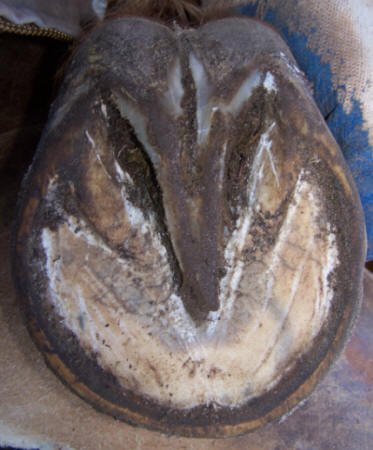
- Key Takeaways
- Recognizing Symptoms and Complications Of Horse Thrush
- Effective Thrush Treatment and Prevention Methods
- Understanding Causes Of Thrush and Risk Factors
- Implementing Thush Prevention Strategies
- Importance of Veterinarian Consultation For Thrush
- Debunking Myths About Horse Thrush
- Managing Severe Thrush Cases
- FAQ
- Q: What is thrush in horses?
- Q: How does thrush develop?
- Q: What are the symptoms of thrush?
- Q: Is thrush painful for the horse?
- Q: How can I prevent thrush in my horse's hooves?
- Q: How can I treat thrush in my horse's hooves?
- Q: Should I call my vet if my horse has thrush?
- Q: Are some horses more prone to thrush than others?
- Q: Can thrush in a horse's foot lead to other complications?
- Q: How can I prevent thrush from becoming a chronic problem?
We’re a community of horse lovers dedicated to keeping our horses healthy. One issue we often grapple with is thrush, a pesky bacterial infection that can cause discomfort and even lameness if ignored.
Let’s delve into recognizing, treating, and preventing this condition. We’re debunking myths, sharing expert advice, and committing to cleaner hooves. Join us as we gallop towards a thrush-free future for our beloved horses.
Key Takeaways
- Regular cleaning of the hooves is essential for preventing and treating thrush.
- Consultation with a veterinarian is necessary for effective treatment and prevention strategies.
- Maintaining a dry and clean environment for the horse helps in preventing thrush.
- Proper hoof care, including trimming and balancing, can help prevent deep clefts and contracted heels that increase the risk of thrush.
Recognizing Symptoms and Complications Of Horse Thrush
As horse owners, it’s important for us to stay alert and recognize the symptoms of thrush. Early detection is key to preventing any complications and helping our horse recover quicker.
Symptoms include a runny, black discharge, dark necrotic areas around the frog, and hoof sensitivity.
Not recognizing symptoms and complications of horse thrush can lead to lameness and damage to sensitive tissue.
Poor equine health can also result from gaps in the hooves and a lack of exercise, which prevents the self-cleaning mechanism of hooves from working properly.
To address this, horse thrush treatment must be applied promptly.
Effective Thrush Treatment and Prevention Methods
Clean the Hoof
The first step is to thoroughly clean the hoof to remove all debris and dirt. Use a hoof pick to gently remove impacted dirt and rocks. Then wash the hoof with mild soap and water to further cleanse the area. Make sure to scrub deep into the crevices of the frog area where thrush bacteria thrive.
Dry the Area
Use clean paper towels or a hair dryer on a low setting to completely dry out the hoof after washing. The thrush-causing bacteria proliferate in moist, dirty environments, so drying the area helps eliminate the infection.
Apply Medication
There are several topical medications available to treat thrush, such as iodine, hydrogen peroxide, bleach, or fungicides. Apply the medication liberally on and around the infected frog area. Make sure to read and follow all label instructions.
Bandage the Hoof
After applying the medication, loosely wrap the hoof with a dry gauze bandage. This helps prevent rubbing off the medication and further protects the treated area from debris. Change the bandage daily when reapplying the medication.
Allow Healing Time
It can take 1-2 weeks for the thrush infection to fully resolve. Be diligent about continued cleaning, drying, and medication application daily throughout the healing period. Keep the horse in a clean, dry environment during recovery.
Maintain Good Hygiene
Once the thrush has resolved, be proactive about hoof hygiene to prevent reinfection. Pick out hooves daily, wash them weekly, apply hoof conditioner, and make sure the environment stays clean and dry. Also, have a farrier periodically trim and balance the hooves.
Understanding Causes Of Thrush and Risk Factors

Now that we’ve covered effective treatment and prevention methods, let’s delve into understanding the causes of thrush and the risk factors involved.
Thrush in horses results from an anaerobic bacterial infection, specifically Fusobacterium necrophorum, which thrives in moist, dark, poorly oxygenated environments.
Recognizing the risk factors is necessary for effective horse thrush treatment and prevention. Here are the primary ones:
- Unhealthy hoof conditions and lack of blood flow can contribute to thrush formation.
- Poor hoof care and maintenance can also lead to thrush.
By ensuring good hoof care and maintaining a clean, dry environment, we can significantly reduce the risk of thrush in our horses.
Implementing Thush Prevention Strategies
Understanding the right strategies to prevent thrush in our horses is vital for ensuring their overall hoof health and well-being. Implementing thrush prevention strategies involves a combination of regular horse care and vigilance. Key aspects include maintaining a clean and dry environment, encouraging regular turnout and exercise, and instilling a routine of daily hoof cleaning.
The use of a hoof pick is critical in removing organic material packed in the hoof, which can provide an ideal breeding ground for thrush-causing bacteria. Regular hoof care should also include prompt inspection and treatment of any signs of thrush, as early intervention can prevent more serious issues.
Importance of Veterinarian Consultation For Thrush
Relying on the expertise of veterinarians plays a significant role in diagnosing and treating thrush in horses. With their extensive knowledge and experience, veterinarians can accurately determine if a horse is suffering from thrush and suggest the most effective treatment. They can provide valuable guidance on preventive measures to maintain your horse’s hooves in good health.
Here’s why:
- Expert Diagnosis:
- Identify subtle signs of thrush
- Differentiate thrush from other hoof issues
- Treatment Recommendations:
- Provide appropriate horse thrush treatment
- Offer advice on proper hoof care
In short, consulting your veterinarian is a key step to ensure that your horse receives the best care possible. The importance of veterinarian consultation for thrush can’t be overstated.
Debunking Myths About Horse Thrush
Continuing from the importance of expert advice in treating thrush, let’s move on to debunking some common myths about this hoof condition.
One common misconception is that thrush only thrives in wet conditions. In reality, thrush is caused by bacteria and fungi and can occur even in dry environments if the horse’s hooves aren’t properly cleaned.
Another myth is that thrush is solely a result of poor stable conditions. While dirty stalls can contribute to thrush, even the cleanest stables can’t prevent it if hoof care is neglected.
The best thrush remedy involves regular hoof cleaning, trimming, and the application of an appropriate horse thrush treatment as recommended by a vet.
Debunking myths about horse thrush helps us focus on the actual thrush causes and effective treatment of thrush.
Managing Severe Thrush Cases
In some instances, horse thrush can become a severe infection that penetrates deep into the hoof. This causes extreme pain and lameness for the horse. Severe thrush often needs veterinary intervention in addition to the following intensive management:
- Clean the hoof thoroughly with soap and water at least twice daily to remove bacteria and diseased tissue. Scrub deeply with a stiff brush to ensure the crevices are sanitized.
- After washing, soak the hoof in a dilute bleach solution (1 part bleach to 10 parts water) for 10-15 minutes to kill the remaining bacteria. Rinse and dry thoroughly.
- Work with your vet to pack the infected frog area daily with medicated gauze after soaking. This maintains contact between medication and infected tissue. Common medications for severe thrush include iodine, copper sulfate, or prescription antibiotics.
- Wrap the treated hoof in a poultice bandage between appointments to prevent debris from entering. Change the bandage whenever it becomes soiled.
- House the horse in a deeply bedded stall and keep it clean and dry. Remove all soiled bedding promptly to prevent infection spread.
- Increase nutritional feeds as recommended by your vet to help tissue healing.
- Take radiographs to check for abscess formation or other complications beneath the hoof surface.
- Schedule regular farrier visits to trim damaged frog tissue and balance the hoof properly during recovery.
- Prevent reinfection through meticulous hygiene once healing occurs.
FAQ
Q: What is thrush in horses?
A: Thrush in horses is a bacterial infection that affects the frog, which is the soft, triangular structure located at the heel of the hoof.
Q: How does thrush develop?
A: Thrush develops when the horse’s hoof remains wet for long periods, creating an ideal environment for bacteria to thrive. The bacteria feed on the organic matter, such as manure, in the hoof, causing an infection.
Q: What are the symptoms of thrush?
A: The symptoms of thrush in horses include a foul odor coming from the affected area, a black, tar-like discharge, and a soft, crumbling texture of the frog.
Q: Is thrush painful for the horse?
A: Yes, thrush can be painful for the horse, especially if it is left untreated and becomes severe. The infection can invade deeper layers of the hoof tissue, leading to discomfort and lameness.
Q: How can I prevent thrush in my horse’s hooves?
A: To prevent thrush, it is important to keep your horse’s hooves clean and dry. Regular hoof cleaning, proper trimming by a farrier, and providing a clean environment can greatly reduce the risk of thrush.
Q: How can I treat thrush in my horse’s hooves?
A: Treatment of thrush involves cleaning the affected area with a mild antiseptic solution, such as iodine or diluted bleach. It is also important to keep the horse’s hooves clean and dry and to apply a hoof treatment specifically designed to combat thrush.
Q: Should I call my vet if my horse has thrush?
A: If your horse has thrush and the condition does not improve with regular hoof cleaning and treatment, it is recommended to consult your vet. They can provide further guidance and assess if any additional treatment is required.
Q: Are some horses more prone to thrush than others?
A: Yes, some horses are more prone to thrush due to factors such as conformation, poor hoof structure, or unhealthy hoof environment. Horses with deep clefts of the frog or those living in damp or dirty conditions have an increased risk for thrush.
Q: Can thrush in a horse’s foot lead to other complications?
A: If left untreated, thrush can lead to more serious complications. The infection can spread to the sensitive tissues of the hoof, causing pain, lameness, and potential damage to the hoof wall.
Q: How can I prevent thrush from becoming a chronic problem?
A: Regular hoof care, including proper trimming, cleaning, and maintaining a dry hoof environment, is key to preventing thrush from becoming a chronic issue. Regular inspections and prompt treatment at the first sign of thrush can also help prevent its recurrence.








